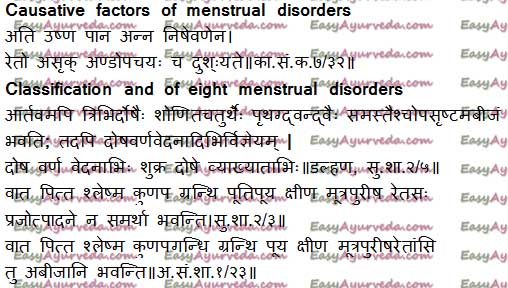Artava Vyapad – Menstrual Disorders Explained In Ayurveda
By Dr Raghuram Y.S. MD (Ay) & Dr Manasa, B.A.M.S
Artava, in Ayurveda is a broad spectrum terminology. It includes study of menstrual blood, menstruation, ovum and ovarian hormones according to various contexts and in various references.
Read – Artava – Menstrual Blood Formation, Healthy Characteristic Features
In this context of Artava Vyapad, Artava will be discussed only in terms and meaning of menstruation.
Artava = menstruation
Vyapath = disorders
Artava Vyapath = disorders of menstruation
Read – Upadhatu Of Rasa Dhatu – Stanya, Arthava: Sub Tissues Of Rasa
Ashta Artava Dushti – Eight kinds of menstrual disorders as explained in Ayurveda.
Table of Contents
Causes
Causative factor of menstrual disorders
Causes for menstrual disorders enumerated by master Kashyapa –
- Administration of nasya i.e. nasal medicines to a woman in menstruation i.e. during menstrual cycle causes disorders of menstruation.
- Excessive consumption of foods and drinks which are hot in quality and potency during menstruation
- Use of excessive medicines for cleansing purposes by woman having soft bowel movements, the woman having been administered with oleation and sudation
Read – Gynecological Disorders Causes, Types As Per Ayurveda
In general it can be said that the specific causative factors responsible for aggravation of particular doshas, added with violation of rules and regulations related to maintenance of health of reproductive system would cause menstrual disorders in women.
Read – Ayurvedic Diet And Lifestyle During Menstruation (Periods)
Sanskrit verses

Classification
Classification of menstrual disorders have been done from two perspectives –
1. Classification of menstrual disorders on the basis of predominant causative dosha
Master Sushruta has enumerated 8 kinds of menstrual disorders. Most authors have followed similar pattern. They are as below mentioned –
- Vataja – caused by vitiated vata
- Pittaja – caused by vitiated pitta
- Kaphaja / shleshmaja – caused by vitiated kapha
- Raktaja – caused by vitiated blood
- Vata-pittaja – caused by simultaneous dual vitiation of vata and pitta
- Pitta-kaphaja – caused by simultaneous dual vitiation of pitta and kapha
- Vata-kaphaja – caused by simultaneous dual vitiation of vata and kapha
- Tridoshaja – caused by simultaneous vitiation of all three doshas
Read – Physiology Of Menstruation, Menstrual Cycle – Ayurvedic Perspective
Salient features of menstrual blood contaminated by doshas / eight menstrual disorders
It is said that the vitiated menstrual blood in all the above said instances does not possess the bija i.e. ovum. Thus, contaminated menstrual blood may meddle with fertility and conception.
Master Harita has mentioned the signs and symptoms and treatment of vataja, pittaja and kaphaja menstrual disorders in the chapter dealing with vandhyatva i.e. infertile women. This further explains that infertility is common in menstrual disorders.
Read – Menstrual Pain, Painful Periods – Natural Ayurvedic Herbal Home Remedies
The signs and symptoms including pain, color of menstrual blood etc in these disorders depend on the predominance of the involved dosha.
The signs and symptoms of menstrual disorders are similar to the similar eight type of seminal disorders i.e. shukra dushti explained by the same authors in earlier contexts.
Read – Hypomenorrhoea: Causes, Remedies, Ayurvedic Treatment
2. Classification of menstrual disorders on the basis of specific clinical features
| Sl No | Name of Artava Dushti | Meaning | Closer gynecological disorder |
| 1 | Vataja | Caused by vitiated vata | Oligomenorrhea with dysmenorrhea caused by nutritional deficiency |
| 2 | Pittaja | Caused by vitiated pitta | Inflammatory condition of reproductive organs due to infection, chronic pelvic cellulitis, associated with oligomenorrhea |
| 3 | Kaphaja | Caused by vitiated kapha | Chronic endometritis or cervicitis associated with oligomenorrhea |
| 4 | Raktaja / Kunapagandhi | Caused by vitiated blood / has smell of dead body | Early stage of endometrial carcinoma |
| 5 | Granthi bhuta | Clots / cystic appearance in the menstrual blood | Malignant disorders of reproductive system specially cervical carcinoma |
| 6 | Putipuya | Menstrual blood appears like rotten pus | Acute infection of reproductive system specially acute endometritis leading to pyometra |
| 7 | Kshina | Menstrual blood less in quantity | Hypo-estrogenic oligomenorrhea caused by nutritional deficiency |
| 8 | Mutra Purisha Gandhi | Menstrual blood has smell of urine and feces | Cervical carcinoma (3 or 4th stage) |
Treatment
Treatment Principles of Menstrual Disorders
Menstrual disorders should be treated on the basis of predominant dosha involved in the pathogenesis.
Body cleansing in the form of therapeutic emesis and purgation and medicinal vaginal enemas are the best remedies for menstrual disorders.
Treatment strategies explained in treating the seminal disorders shall be implemented, especially oleation, sudation and rejuvenation therapies.
Local treatments in the form of pessaries and application of medicinal pastes prepared as per condition shall be used.
Suitable dietetic regimen should be followed.
Apart from these eight menstrual disorders, other forms of menstrual disorders are explained under different terms i.e. asrgdhara, nashtartava, artava kshaya, artava ativriddhi etc. The summation of all these conditions forms a comprehensive explanation of menstrual disorders.
Medicinal Formulation for Arthava Suddhi From Sahasra Yoga Text Book
Arthava Sodhana Kashaya
Medicinal Formulation for Stree Roga From Sahasra Yoga Text Book
Ashtapatra Taila
Chandanadi Choorna
Click to Consult Dr Raghuram Y.S. MD (Ayu) – Email / Skype









